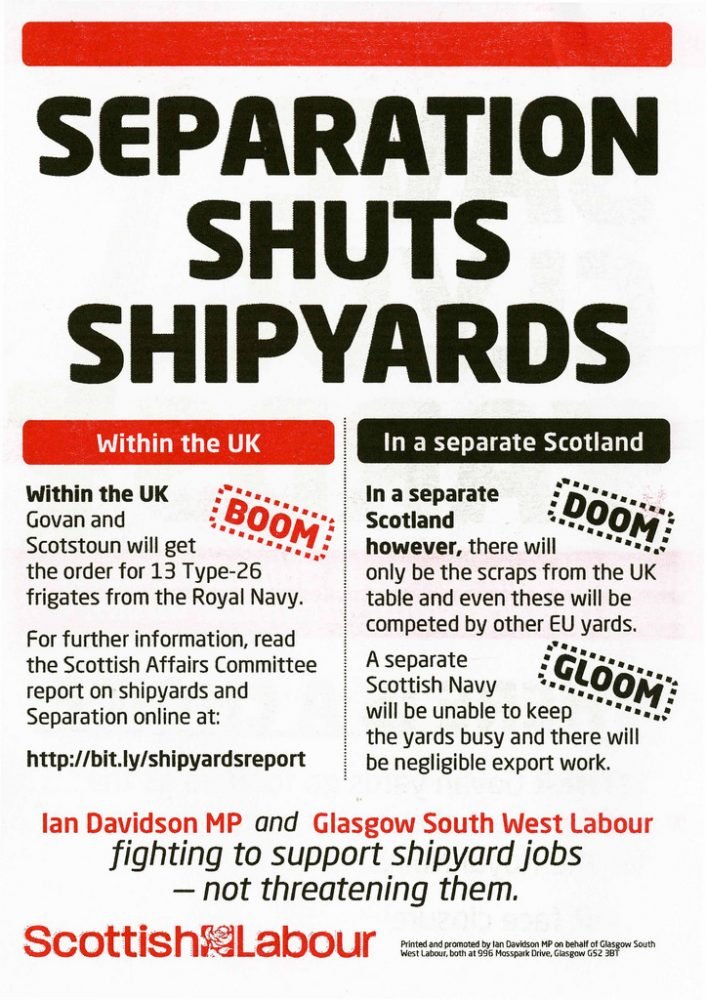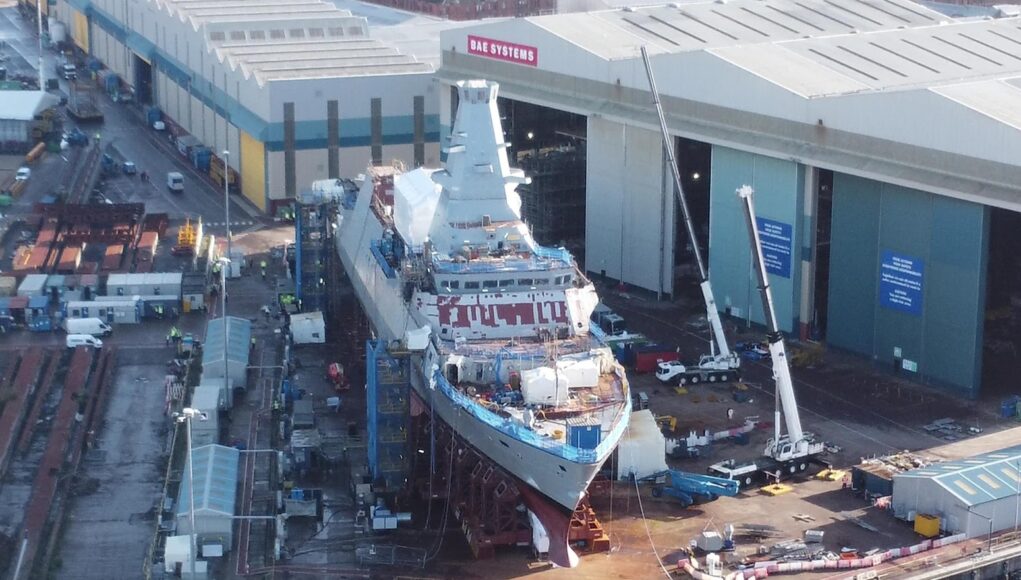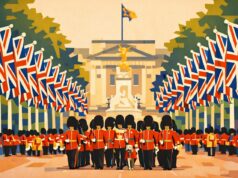As you read this, Scottish shipyards have orders for 13 frigates. There are some on social media, however, that are completely unaware of this but still have very strong opinions on the matter – but why?
During the run-up to the 2014 Scottish independence referendum, political campaigners hoping that Scotland would remain part of the United Kingdom made a big deal about the then-planned thirteen Type 26 Frigates the Clyde was to build. Those Type 26 Frigates ended up delayed, of course, and to fill the gap one batch of two and another batch of three Offshore Patrol Vessels were ordered to keep the workforce skilled and employed.
This article is the opinion of the author and not necessarily that of the UK Defence Journal. If you would like to submit your own article on this topic or any other, please see our submission guidelines.
Then the 2015 Strategic Defence and Security Review came, and long story short it resulted in the change from thirteen Type 26 frigates to eight Type 26 Frigates to be built at Govan and five Type 31 frigates to be built at Rosyth. Due to commercial considerations, budget issues and a delay to work starting on the new frigates… thirteen frigates at one yard became eighteen of three types at two yards. A Ukrainian warship has also since been ordered at Rosyth, paid for with a loan from the UK Government. More work for more people at more locations, that’s a good result isn’t it?
The shipbuilders seem to think so. I spoke to a contact who wishes to remain anonymous, he told me:
“This is great for the industry, a second yard building complex warships keeps more people in work and sets the yards up for larger programmes of follow-on work. It’s no secret that we’ll likely be building the Type 45 replacement, we’ve got work for decades and now so does Babcock at Rosyth.”
Well, if all is so good why am I writing this? Because despite this information being easily verifiable and heavily reported, people seem unaware of it. ‘We were told this in 2014!’, ‘The ships were cancelled!’ or ‘More lies from Wastemonster’, anyone?
What’s being said?
There are literally thousands of tweets about this, ranging from absurd claims that no ships are being built at all to more understandable but still false claims that only five ships have been ordered. The former, I assume is either wilful ignorance and the latter is clearly from folk that are unfamiliar with the fact that ships are ordered in batches.
Below are some of the more concerning examples.
This is one of the more common examples, shared in an echo chamber and absent of fact checking.
https://twitter.com/weemokerr/status/1594102868147113984
This user, seemingly unaware of the multi-year long contract negotiation process between BAE and the Ministry of Defence has confidently asserted that the new order must be a lie as he hasn’t observed the tendering process.
https://twitter.com/6171tara/status/1592779687084060672
Media watch here trying to correct the Tories, which by the way, have had more than their fair share of procurement gaffs worthy of attention. Ordering frigates, however, just isn’t one of them in my opinion.
So in 2014 before IndyRef the Tories promised to build 13 type 26 Frigates on the Clyde. Eight years later only three have actually been ordered. Now before the next IndyRef you promise to build another five. You lied the last time and you're lying now.#YesScots 🏴
— mediawatch (@indy_jh) November 15, 2022
Then, of course, there are the outright lies.
No they're not. Three are… And they aren't being BUILT here. They're being built ELSEWHERE & put together here. That's ALL. And I know for FACT. My daughter lives right next door to the shipyard. The workers talk…
— Tarisgal (@tarisgal42) November 15, 2022
On all social media platforms, you’ll find thousands of more comments (oddly many are from accounts that bill themselves as some sort of champion against “media lies”, correcting what they call “bias” but actually just appears to be reporting on a topic they’re not very familiar with) from people that genuinely believe the last batch of ships didn’t happen or that it’s some extravagant ploy to trick Scotland somehow.
What’s on the books?
I've updated my chart of Scottish naval shipbuilding (again) for 2014-2035. Since 2014, seven ships have been launched in Scotland (two carriers and five patrol ships). In addition, there are orders for 13 frigates and 1 Ukrainian naval vessel. pic.twitter.com/WBS8IlTR7W
— George Allison (@geoallison) November 18, 2022
Why are some convinced this is a bad thing?
Jonathan Chartier, a defence commentator, took a detailed look at this. He said that one key issue that has had significant influence over the often torrid debate when it comes to military ship building in Scotland is the reduction of the Type 26 procurement from thirteen to eight vessels.
“The often passionate arguments from those who support and oppose Scottish independence makes a balanced view of military ship building in Scotland and its future difficult, as it can often end up with people shouting their ‘preferred’ facts at each other over social media rather than examining the issues. Traditionally, the Royal Navy has purchased ship classes from multiple yards, in distinct batches. This not only spreads programme costs, but also allows for changes and improvements to the base design and rectification work, as well as for keeping shipyards open with a constant steady stream of work. Certainly, for famous classes like the Type 12I Leander, this batch production was necessary just to keep up with the radical changes seen in electronics and systems over their extensive career.”
Ordering in batches is common
“So, whilst the Royal Navy would have a projected number to be built, it was not unusual for the number of batches to be reduced or, on some occasions, increased as needed without comment by the wider general public to satisfy the requirements of the Admiralty and – always lurking in the background – the Treasury. This practice continued through to the Type 23 class, which was built by competing yards Marconi Marine (YSL) in Scotstoun, and Swan Hunter in Wallsend. Interesting fact: you can tell where an individual Type 23 was built by inspecting its internal pipe fittings.
When it came to the Type 45 class, the Royal Navy projected a fleet size of twelve, split into multiple batches. A first batch of three vessels using modular construction would be split between two yards for final build with BAE Systems Marine on the Clyde and Vosper Thornycroft (VT) in Portsmouth. VT had actually built a new hall or “Ship Factory” with a new panel line to accommodate this work.
Nevertheless, BAE Systems Marine persuaded the Government of the time that it would be more cost effective for the final build to be on the Clyde, and VT ended up only providing sections. This caused much ongoing grievance amongst the people of Portsmouth, exacerbated by the eventual ending of ship building in Portsmouth in favour of the Clyde after the rationalisation of UK military shipbuilding as part of the often-talked-about Terms of Business Agreement with BAE Systems.
As it is well known, the order for Type 45 was reduced from twelve down to eight and eventually six. A change that had significant operational and political consequences that go beyond the scope of this article.”
Warship building has been consolidated in Scotland
“With warship construction consolidated on the Clyde, Type 26 was projected to be a build of 13 vessels; again, through multiple batches in keeping with common practice. For those familiar with military ship building, the 13 projected was at best a placeholder subject to change.
Certainly, it was well known in the period after the 2010 Strategic Defence and Security review that the equipment programme was once again being put under extreme financial pressure. Under this circumstance, it was unfortunate that the Scottish independence referendum, David Cameron, and the Better Together campaign unwisely turned routine procurement that could be subject to change into a political football game by making a direct promise to Scotland that 13 Type 26s would be built on the Clyde alongside a new Frigate Factory.”
Party politics played their part
“The Labour Party exacerbated the situation with a leaflet spelling out that if Scotland remained in the Union, it would get 13 Type 26 frigates. The Prime Minister and other Ministers plus representatives of the Better Together Campaign also regularly spelled out that a Scotland in the Union would be getting 13 Type 26 frigates.”

“So, when the referendum was over and Better Together had won, the reality that 13 Type 26 frigates were not deliverable within the allocated budget set in. A few months after cast-iron guarantees for 13 Type 26 frigates, the order was cut to eight as part of the 2015 Strategic Defence and Security, with a compensatory order for five general purpose frigates proffered and some Offshore Patrol Vessels ordered in their place.
Not that the Yes campaign and SNP get away from broken promises or, more accurately, promises they couldn’t guarantee as deliverable, when it comes to military ship building and the 2014 independence referendum. The SNP position on the future of not only military ship building but also a future Scottish Navy was wholly unrealistic. During a transition period to independence, Scottish Shipyards would certainly need to complete any ongoing orders, or at the very least, what was already in build. But they certainly couldn’t guarantee the promises they made about the UK Ministry of Defence (MOD) and Royal Navy (RN) placing future orders with yards in a newly independent Scotland.”
“Technically” a broken promise
Considering what was promised in very clear terms by the Prime Minister, Better Together and other parties including Labour, it is understandable why Scottish Nationalists have fixated on it as a totemic issue. Put simply: 13 Type 26 frigates was a core promise by Better Together in the Independence campaign that has been, technically, broken.
Of course, the more nuanced point to be considered is that Scotland gained five River class Batch II Offshore Patrol Vessels and five Type 31 frigates (plus a “frigate factory” in Rosyth) as compensation for the loss. Scotland ended up with more shipbuilding work than promised as a result.
An echo-chamber
It seems very clear that social media, rather than the people using it, is to blame.
Social media encourages echo-chambers in which confirmation bias runs rampant. Essentially, people are shown news items that confirm what they already believe. Our social media feeds are personalised based on past clicks and likes behaviour, so we mostly consume political content that are similar to our views.
Without realising it, we develop tunnel vision.
Rarely will our comfort zones expose us to opposing views, and as a result we eventually become victims to our own biases. There are some studies that measure echo chamber effects, such as the study of Bakshy et al. (2015). In this study, they found that people tend to share news articles they align with. In addition to this, they discovered a homophily in the friendships online, meaning people are more likely to be connected on social media if they have the same political ideology.
This isn’t unique to Scotland, or shipbuilding, or any political party. It is a symptom of how social media influences debate. I don’t know how to fix it, I only know that it should be fixed.
It’s not just frigates either, ferries are the victim of ill-informed speculation, you can read more about that below or by clicking here.














The truth doesn’t seem to matter in the social media world.
Lies breed more lies. If you read lies as truth then spout those same lies it builds a base.
I think the main thing is that outside of the twittersphere of media and political commentators no one really cares. Shipbuilding in the Clyde has zero affect on the Scottish independence debate. Glasgow was the biggest voter for independence despite the implications of loosing these yards and no rational person thinks these yards would survive Scottish independence but still no one really cares. Even the guys working there don’t care enough. It’s not like skilled metal workers and ship builders won’t pick up new jobs in 5 minutes in another elated field.
Scottish independence is just like Brexit, rational economic arguments mean very little on either side.
Brexit, like the EU, like the Independence debate, like the strategic oil reserve is all about politics. Everything else lubricates those discussions.
Your article is of course correct but I think the government is part to blame in its message. The recent headlines were: “Government orders 5 new frigates.” (As though this is a reaction to the war in Ukraine). Now this makes it look like a new order – which it is, but it’s an order that was always going to be made because as you say, the ships are built in batches and the decision was actually made years ago. So it’s not really a new order at all but it is bound to confuse the more brain dead among us and those that don’t follow the narrative over the years. Same with the Type 31s. If the government said right from the start they would order 13 frigates of various types in batches from various Scottish yards between this date and that date, even retards would be able to understand it. But now, for Rishis, it looks like he is doing something new and wonderful. I can see why people are confused, and it doesn’t matter now what the Journal says, because mere facts won’t now convince anyone.
Exactly – reductionism is the enemy of the people.
Had to look that up, but yes, you’re right!
What’s so strange about that? It’s very hard finding facts about controversial stuff through social media. It’s not just echo chambers, but one of the problems is dissenting opinions are just shot down without meaningful debate. Getting called out for putting up facts, while falsehoods are easily accepted as truths. A weird world really.
On a side note, I never new about the ship building industry while living in Scotland. Only found out about it years later after I left. I assume it’s still not something that is clearly visible?
Well done George for persisting with your debate with the blockheads. You are absolutely correct about social media today; utterly irresponsible. At least the disinformation flying about on this topic won’t cost lives.
Scotland has cornered the market (almost) for building ships for the Navy for years to come. But showing evidence to people whose minds are made up is, as I have found with long experience, futile.
It’s also good news that Ferguson Marine is having a second chance. Here’s wishing them well.
Maybe those working in these shipyards are not too worried? Because if the scots get independence and ship building moves south they know they would probably get jobs there as their skills would be needed….maybe?
Should all be built in England instead of building in a nation that is growing ever more bitter and hostile to the UK.
I don’t think Scotland is growing more hostile to the UK – but there is a determined and bloody-minded rump who will never be satisfied until the flag of Union is removed from every Scottish building. Like all activists they destroy the debate and just promote hostility.
I’ve come to the conclusion than all activism should be opposed in a similar bloody-minded fashion as permitting their continued hostilities only undermines the democratic process and elevates fringe ideas and beliefs far above their station and national support.
it’s one hell of a big rump! it’s called democracy!
Many of these claims are true. Better Together, Conservatives and Labour all promised one single order of 13 Type 26 frigates. Post referendum there was one order of 3 Type 26 frigates. Promise broken.
Short,sharp,blunt and rigid thought patterns…whatever is said to you on this subject..by experts…. you cannot and never will it accept as the truth
Instalment plans must surely blow your mind.
Because a classic principle of negotiation is that if you paint yourself as being disadvantaged, you get to demand more in order to achieve an “equitable” outcome.
The problem is that if an Union is build only because frigates or other contracts it will not have a long live…
There was s a reason I no longer use the phrase ” how stupid can you get?”
Instead of taking it as an insult they seem to be viewing it as a challenge.
Batch building warships is nothing new, in WW2 my Dad’s ship HMS Avon (K97) was a Batch 2 River class frigates built at Hills yard in Bristol in 1943. In all, there were 3 Batches.